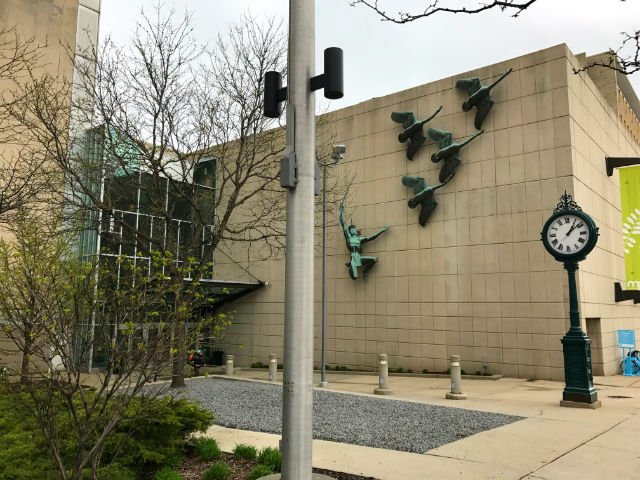While some in Milwaukee are thinking about the long-range outlook for the future of the Milwaukee Public Museum and its home at 800 W. Wells St., the museum is partnering with The Green Team of Wisconsin and others to revitalize its Wells Street entrance.
The groups are collaborating with Milwaukee Metropolitan Sewerage District and Fund for Lake Michigan to better manage stormwater runoff into the deep tunnel from the museum site.
The Green Infrastructure Demonstration Garden project was drawn by Hanging Gardens – which has expertise in vegetated roofing, stormwater mitigation, and bioremediation – in collaboration with staff from The Green Team, a sustainable landscaping company, and Milwaukee Public Museum.
MMSD and the Fund for Lake Michigan are providing funding in the form of grants.

"The courtyard will become an inviting space and a more worthy entrance to our great museum, featuring bright, open spaces, native plantings and teaching gardens, all with educational and informative signage," said The Green Team of Wisconsin Business Manager Matt Astbury.
"This is a catalyst project that makes the space more usable and engaging for self-tours and especially for the tens of thousands of students that visit annually and will be complete with a small stage for educators or entertainment."

"Other elements will now connect the landscape to what’s happening elsewhere at MPM, like highlighting the solar panel, green roof and the butterfly exhibit by way of pollinator garden. Raised beds will highlight the pathway and history of food into our culture, as well as indigenous cultures uses various plants for medicine or dyes for clothes."
The fully grant-funded plan – for which the museum raised more than $100,000 – includes native landscaping – with stormwater trees that drink up moisture – in the 9,500-square foot sunken entrance area that is currently underutilized by the museum, but that has the opportunity to become not only a showplace but a welcoming entrance to the museum and a usable space for patrons and the neighborhood.
There will also be porous pavement to allow water to return to the soil beneath; rain barrels and cisterns to collect water for reuse; and bioswales to help remove silt and pollutants from water as it seeps back into the ground.
In its description of the project document, Hillary Olson, the museum’s vice president of audience and community engagement, wrote, "Our goal is to design the entry space, not only to serve as additional infrastructure for volume stormwater collection and management, but also to serve as an educational tool to educate and inspire thousands of MPM visitors about the possibilities of going green themselves."
The project follows in a series of green initiatives undertaken by the museum in recent years, including a green roof and a solar array installed on the facade in 2014. The project also includes a descriptive panel that will highlight the museum's green roof.
Museum CEO Dennis Kois has said the current museum building, which dates to the early 1960s, is extremely inefficient and expensive in terms of utilities usage. That cost is part of what’s fueling the drive for a new museum building.
"MPM is thrilled to be partnering with the Green Team and Hanging Gardens with support from the Fund for Lake Michigan and the Milwaukee Metropolitan Sewerage District to transform our Wells Street courtyard into a green oasis that will be used for museum activities and demonstrations," said Olson.

"The space itself will be a demonstration of green infrastructure, including water management and native species gardening, which we're excited to share with the Milwaukee community."
A second phase of the plan projects another 7,500 square feet of green space on the west side of the building. That work would begin upon the completion of the work out in front.
According to the plan, the elements of the projects will have a lifespan ranging from more than 10 years (native landscaping), to 25 years (bioswales) to indefinite (cisterns, rain barrels, porous pavement).
So, why do this when the museum is considering moving?
"It will be at least 10 years before the museum could move into a new building," said Olson. "In the meantime, it’s important for us to continue providing the community educational opportunities. This project will be the third green infrastructure project we have completed. We are certain that our audience will enjoy learning about the use of rainwater as much as they’ve enjoyed learning about our solar wall and green roof."
The project is slated to begin June 15 and be completed by July 31.
Born in Brooklyn, N.Y., where he lived until he was 17, Bobby received his BA-Mass Communications from UWM in 1989 and has lived in Walker's Point, Bay View, Enderis Park, South Milwaukee and on the East Side.
He has published three non-fiction books in Italy – including one about an event in Milwaukee history, which was published in the U.S. in autumn 2010. Four more books, all about Milwaukee, have been published by The History Press.
With his most recent band, The Yell Leaders, Bobby released four LPs and had a songs featured in episodes of TV's "Party of Five" and "Dawson's Creek," and films in Japan, South America and the U.S. The Yell Leaders were named the best unsigned band in their region by VH-1 as part of its Rock Across America 1998 Tour. Most recently, the band contributed tracks to a UK vinyl/CD tribute to the Redskins and collaborated on a track with Italian novelist Enrico Remmert.
He's produced three installments of the "OMCD" series of local music compilations for OnMilwaukee.com and in 2007 produced a CD of Italian music and poetry.
In 2005, he was awarded the City of Asti's (Italy) Journalism Prize for his work focusing on that area. He has also won awards from the Milwaukee Press Club.
He has be heard on 88Nine Radio Milwaukee talking about his "Urban Spelunking" series of stories, in that station's most popular podcast.







